Kate Rauner's Blog, page 107
July 22, 2013
Glitch – my new Sci-Fi enovel Chapter 2
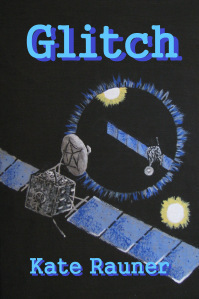 You can read Chapter 1 here
You can read Chapter 1 here
Glitch is available now for $2.99. You can read a longer excerpt or purchase Glitch for Kindle on Amazon or, for all other e-formats, read a longer excerpt or purchase at Smashwords For a limited time, you can purchase Glitch for half-price at Smashwords. Use coupon code YS46M before July 31.
Glitch is available at Amazon , Barnes & Noble , Apple, Inktera, Versent, Kobo, Diesel, and on Smashwords .
Chapter 2 Glitch
As he sat with his coffee cradled in one hand, Rob tapped his virtual keyboard and displayed an animation of MEG1 to the center wall screen. Xplore’s systems built the animation from the telemetry being received. MEG1 rotated the satellite Trisha had selected towards the sun. With another tap, Rob sent the satellite’s visible-light image to the left wall screen. Mars slid slowly across the left screen as MEG1 rotated into position and the sun moved into view in its place.
For someone standing on Mars, the sun would look about half the size it does from Earth, and no brighter than the sun might appear on a cloudy Earth day. But floating in black space, with nothing for comparison, MEG1′s image of the sun seemed exceptionally brilliant. The sun was so bright it swamped out the view of any background stars and dominated the screen. Rob adjusted the zoom until the sun occupied a quarter of the screen’s surface. The sun sat right in the center once MEG1 had completed her rotation, and Rob relaxed back into his chair. His work was done, barring trouble, and now he could just watch the data stream in as the researchers at Arizona and UPMC exercised their instruments.
Light imagers, spectrometers, and a topography-measuring laser altimeter were among the gadgets MEG1′s satellites carried. Not all could be tested in open space. She needed an object below her to measure topography, for example. Arizona’s visible-light image was more easily evaluated. Arizona was fiddling with something and the image quality improved. Filters were being adjusted, Rob noted, glancing at his work station screen.
A blank spectroscopy chart popped up on the right-most wall screen in preparation for displaying the French university’s data. Xplore was contracted to store the data, so they were receiving the telemetry at the same time as the spectroscopists, but UPMC was selecting the display mode. Rob glanced at the storage status displayed at his work station. No problems.
The spectroscopists were located at UPMC in France, the Université Pierre et Marie Curie, at the university’s laboratory of planetary science.
Rob understood the lab was right along the Seine River. ‘Sounds like a nice place to locate mission control,’ he thought idly as the university control rooms took over the calibration run.
MEG1′s telemetry indicated the spectroscopy instruments were warming up, the observation port was fully open, and a spectrum began to fill in the chart on the wall screen. Since the sun’s composition is well known, it made an excellent calibration standard. The sun is mostly hydrogen with some helium, a little oxygen, and traces of carbon, iron, sulfur, nitrogen, silicon, and neon. Colors and lines formed and brightened as the spectrum formed.
The French crew was busy checking various functions. Rob had their chat appearing as text crawling across the bottom of his work station screen. He checked the crawl from time to time in case they had problems he should be solving. But generally, Rob watched the view of the sun on the wall screen. His mind began to drift as he stared at the bright disk.
‘The sun is rising right now outside,’ he thought, glancing at the local time. He could only tell by the clock, since the light levels in the windowless control room never varied.
Then something caught his eye. Abruptly, Rob sat up straight.
“What’s that?” he said out loud. “Is something changing?” Turning on the voice connection to Arizona, he said into his headset mic, “Arizona, are you losing your imager?”
“No. Everything is good here. Why?”
“Why is the sun getting squished?”
 Sure enough, the sun was no longer a perfect bright disk. One side was slightly flattened.
Sure enough, the sun was no longer a perfect bright disk. One side was slightly flattened.
“Hey, you’re right Xplore. We show the brightness down three percent. Stand by. Checking.”
Lee scowled at the wall screen. “The spectrum is showing less intensity, too, I think. Yes, UPMC confirms a three percent drop.” Lee tapped his controls. There was no doubt about the flattening now. It was definitely visible along one edge of the disk.
“Does that look like an eclipse starting to move across to the sun?” Lee asked.
‘Dammit, dammit, dammit’ Rob thought as he pulled up various charts. They all told him the same thing as the visible-light image on the wall screen.
“Are we behind an asteroid?” he asked out loud.
“That would be an incredible piece of bad luck,” Lee said. “We’re not near any of the large asteroids. For something to look that big against the sun, MEG1 would have to be right on top of it.”
“We are looking towards the sun,” Lee continued. “If there were an asteroid, we’d be looking at the night side, so it would be a dark blob.”
“No, no, no!” Rob said through his teeth, hoping to banish the possibility. “If we steered MEG1 into an asteroid, we’re in trouble.”
“Trisha! Ping that blob. How close is it? And how big?”
Trisha tapped at her controls, selected a packet from a command menu, and hit ‘send’. They’d have to wait for the transmission going out and coming back, plus however long it took for MEG1 to send a signal and have it reflected back to her.
“I’ve sent commands to emit a radar pulse and record the bounce-back. If that blob is close, we’ll have an answer in…”, Trisha looked at her work station screen, “ten or twelve minutes.”
Rob pulled out his personal pocket pad and dropped it into his lap, out of sight of the net-cams. He opened his message center, and tapped out a line.
‘r u ther?’
Rachel Davis was an old friend; an old girl friend. They had been graduate students together at the University of Arizona. Rob had figured out he really liked the nuts and bolts of space flight, rather than the big questions of the PhD program. He’d left with a Masters degree, which was viewed as a booby prize by the rest of the class, and started working at Xplore five years ago. Rachel had finished her PhD. Now she and two business partners owned “Southern Skies”, a telescopes-for-hire company. They had some awesome instruments set up in the Red Center of Australia. Where it was night, right now. Where MEG1 was visible, in the constellation of Taurus. Where, maybe, a rogue asteroid could be spotted.
‘Hi Rob.’ Her answer came back right away. For privacy, Rob kept his personal pocket pad set to text-only while he was at work.
‘crisis here image 4 me?’
Rob pulled up some navigation tables on his work station and carefully tapped in MEG1′s right ascension and declination.
‘RA 21 40 41 Dec -23 11 01′
Rachel came right back.
‘This is a business you know. I’m imaging for a paying customer now.’ She must have her messages set to complete sentences, or maybe she was talking into a headset.
‘crashing in2 asteroid. Plz,‘ Rob sent back. He was in no mood for banter.
‘I’m already entering the coordinates. You realize I can’t see your piddily little space craft?’
‘look 4 asteroid.’
‘Okay. The scope is moving now. It’ll take some time to collect enough light for a decent image. I’ll call when it’s done.’
‘thx gotta go’
‘I really should leave this thing on auto-complete,’ he thought, changing the option on the pad. ‘My messages look stupid otherwise.’
Rob slid his pad back into his shirt pocket and looked up at the wall screens. There was now a clear, flat edge of black along one side of the sun’s disk.
‘I can always count on Rachel,’ Rob thought, trying to calm his trembling fingers with a deep breath. He had no more time to think about her. Chatter from Arizona and France was crawling across the bottom of his screen. Everything was functioning perfectly, but the sun was slipping away on the screen.
“Trisha! Ping that thing again. And anything around MEG1 in any direction. I want to know exactly where she is. Are any gravity sources pulling on us? Has our trajectory changed?”
“Lee!” he called. “Turn on the topography laser. Can we see any kind of surface?”
“Already on it.” Lee had a menu of commands on his work station.
“There. Sent.” Lee leaned back in his chair. “MEG1 will look for a surface. Now we just have to wait.”
The time lag had never seemed longer. But MEG1 was half way to her destination around Jupiter, and even light took an annoying amount of time to travel that far. Rob used the time to send alerts.
‘We have encountered an anomaly,’ he sent to Terri Yuan, Xplore’s project manager for MEG; Dr. Gary Rivera, MEG’s principal investigator at Arizona; the next shift’s crew leader; and the rest of a short list of key personnel. ‘See this link.’
They would all be able to view the same frames the crew had on the control room wall screens. It was still early in the morning, but Rob flagged the message as urgent; most people would have their ComCores set to wake them up for urgent messages. Questions would start flooding in shortly. The Internet site would be lighting up, too, since somewhere in the world, subscribers would be watching even while MEG’s principal investigator slept.
Rob looked up at the wall screens. The sun had a significant section cut off now, and the blackness had a slight convex curve.
“I’m getting zilch from topography,” Lee said. “There’s nothing there.”
“And so far, zero trajectory deviation,” Trisha reported.
Rob ran a hand across his tight, short curls, and then leaned forward with his elbows on the bench and his chin against his knuckles.
“Then what the devil…” he whispered, mostly to himself, “are we looking at?”
Glitch, my new science fiction ebook, is available at Amazon , Barnes & Noble , Apple, Inktera, Versent, Kobo, Diesel, and on Smashwords .








July 20, 2013
Population Decline – Disaster or Opportunity? or Both?

Abandoned barn by Dean McCoy
The coming drop in world population was in the news earlier in the year. Many outlets, for example, Time and Slate have run articles about the projected decline. “Experts say the rate of population growth will continue to slow and that the total population will eventually — likely within our lifetimes — fall.” I live in a rural area, and I know that the census shows my county and other rural areas are losing population, but the thought that the whole world’s population will decline is hard to absorb.
Americans are used to our population growing thanks to immigration, and Americans of my era recall The Population Bomb and other dire warnings of overpopulation. It seems the future will be different than the prophets of doom predicted. What will a falling population mean?
Not the end of humanity: Making a straight-line extrapolation to human extinction seems silly; the opposite extreme from Gideon (that is, the overpopulated planet Gideon from Star Trek TOS). But our culture and our economic success are so dependent on growth; it’s hard to know what a successful shrinking world will look like. It will be harder to justify infrastructure in many areas. Maybe sections of cities will be returned to open space or farm land. More rural towns will become ghost towns. This is a great futurist topic for science fiction – and not just dystopias.
Perhaps our thinking should combine the population trend with the “hollowing out” of middle class jobs. Those jobs are being lost, in part, to technological advances. Improved technology could mean lower prices, so maybe low-wage workers will be able to afford decent housing, good food, and entertainment. Maybe the trends towards renting rather than owning will save people money and headaches. If my car breaks down, I’d love to just call the cab company and say, “send me another ride now.”
The future will be different from today, and probably it will be just fine. A major cause of population decline is improved education, most notably for women. There is reason to hope our smarter posterity will figure it out. We mostly did.








July 17, 2013
Abandoning a Book
 Here is an interesting survey of why readers give up on a novel. Also, the top five current books and classics that Goodreads readers never finished. The top reason to abandon a book is, the book is boring. For those of us who try to write, maybe it’s comforting to know even best-sellers leave some people bored.
Here is an interesting survey of why readers give up on a novel. Also, the top five current books and classics that Goodreads readers never finished. The top reason to abandon a book is, the book is boring. For those of us who try to write, maybe it’s comforting to know even best-sellers leave some people bored.
With current books, people have different tastes and interests so it makes sense to me they enjoy different books. With classics, I think when a book finally becomes a “classic”, its time may have come and gone. In high school I was a good girl and dutifully dragged my eyes across every book assigned, except one. I could not get through A Portrait of the Artists as a Young Man. I don’t think anyone else in the class did, either.
Recently I reviewed Encounter with Tiber by Buzz Aldrin and John Barnes. This book is hard science fiction at its best and at its worst. Technology and the science are the main characters. You may love or hate this book, which will say as much about you as it does about the book. I liked it and finished it, but I must admit the level of detail got to be too much for me in places and I skimmed sections. This is an example of a book that some readers will abandon but others will love.








July 13, 2013
Right or Wrong – a Poem
With thanks to Issac Asimov and his book The Relativity of Wrong.
Wrong and Wronger
By Kate Rauner
Answers can be right or wrong, that’s what we learn in school.
Close answers that get closer still, in science that’s the rule.
The teacher says “spell sugar”. I say s-h-u-g-r
But if you spell it p-j-q, I’m righter than you are.
Newton’s laws were not disproved when Einstein came along.
They still apply within their frame, so Newton was not wrong.
Right keeps getting righter
As science goes on longer.
If you think it’s all the same,
You’re wrongest of the wronger.








July 10, 2013
Writers, Readers, Poets: Festival of the Written Word this September
 If you are looking for a wonderful weekend in Southwest New Mexico, consider Silver City’s first Southwest Festival of the Written Word, September 27 -29. http://www.swwordfiesta.org/
If you are looking for a wonderful weekend in Southwest New Mexico, consider Silver City’s first Southwest Festival of the Written Word, September 27 -29. http://www.swwordfiesta.org/

A view along Bullard Street
“Celebrate the power and beauty of the written word, embracing the rich diversity of Southwestern cultures.” The Festival will bring together those who create with those who appreciate the written word.
Some 50 presenters—fiction and nonfiction writers, poets, bloggers, journalists, lyricists, editors, dramatists, and publishers from throughout the Southwest—will be featured in more than 30 sessions and workshops. There will also be a full slate of children’s activities. Thanks to support from Western New Mexico University and other sponsors, most of the Festival events will be offered to the public free of charge. Information and prices for those activities requiring tickets or registration fees will be announced soon.

A view on Bullard Street

Santa Rita Pit at the Chino copper mine
Silver City is my home; I live a little outside the town. I chose to move here from the busy Front Range of Colorado and I think it is a pretty nifty place. Long a campsite for Native Americans and Spanish Mexicans, Americans founded the current town after silver was discovered in the 1860s. This rough and tumble frontier town, where Billy the Kid once lived and his mother is buried, is still known for mining today. The world’s third largest open pit copper mine operates a short distance outside of town, the pit occupies the space where the mining town of Santa Rita once stood. Western New Mexico University, an arts district, historic old-town, and Boston Hill open space round out the town. The huge Gila National Forest and near-by Cliff Dwellings also beckon tourists. The Festival is a great excuse for a visit.
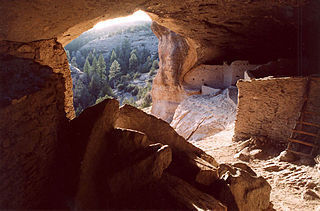
View from inside one of the Gila Cliff Dwellings
July 9, 2013
Encounter with Tiber – hard sci-fi novel review
 Encounter with Tiber, by Buzz Aldrin and John Barnes, is a hard science fiction story for fans of space travel and colonization of the Moon and Mars. The long book (570 pages plus a foreword by Arthur C. Clarke and biographies of the authors) contains two related stories framed within a future historian’s voyage to Tiber.
Encounter with Tiber, by Buzz Aldrin and John Barnes, is a hard science fiction story for fans of space travel and colonization of the Moon and Mars. The long book (570 pages plus a foreword by Arthur C. Clarke and biographies of the authors) contains two related stories framed within a future historian’s voyage to Tiber.
One story starts with an alternative history of the end of the shuttle program and continues into the very near future with explorations of the Moon and Mars. This story is thick with detailed descriptions of technology and includes concepts familiar to fans of Aldrin’s writing, like the Mars to Earth cycler spacecraft. Indeed, long stretches of this story seems to lay a plot on top of his non-fiction book, Mission to Mars.
Here are a couple examples of the level of detail: “He disconnected the tube that supplied him with breathing oxygen from the place where it entered his suit on his left thigh” and “Clancy clamps, toothed clamps on a piece of pipe that tightened their grip when a small disk on the pipe was spun to the right.” This level of detail is not needed to advance the plot or understand the characters; it gives a realistic feel for being an astronaut in space.
The second story tells of humanoids (very human in nature) who came to Earth in the past, seeking a new home for their doomed race. This story is similarly full of scientific details, for example: “The closer a body comes to a large mass, like the Sun, the stronger the tidal effects – and the more difference in tidal effect there is from one side of the body to the other.” While this story contains more speculative technology, it has a similar realistic feel.
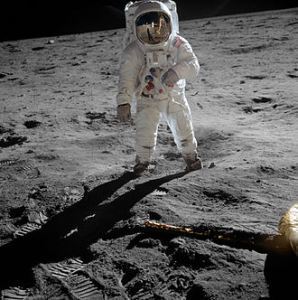
Buzz Aldrin on the Moon, Apollo 11, by NASA Headquarters of the United States under Photo ID: AS11-40-5903.
The book also deals with the politics of space. A recurring theme in both stories is political pressure leads to poor decisions and tragedy. Since Aldrin has been part of NASA’s space program for so long (yes, he is that Buzz Aldrin, the second man to walk on the Moon), it makes me wonder about the real-life events led to this pervasive element.
Even in moments of strong plot action, the authors will divert into technical details, which can make the book slow to read. It requires more concentration than a typical fun summer vacation book, and several times when I was tempted to start skimming, I put it down for a while.
If you are not a hard science fiction/space fiction fan, you may find this book tedious. If you love the details a space insider can provide, you’ll be fascinated.








July 8, 2013
Words Vs. Reality
 Is Pluto a planet? Is a virus alive? How can a Scutellosaurus mom lay a Stegosaurus egg? There are many mysteries in the natural world, but these are not among them. These are mysteries of classification. We humans like to organize the world into tidy categories. Sometimes the words we compose can become more important to us than the reality they are supposed to describe.
Is Pluto a planet? Is a virus alive? How can a Scutellosaurus mom lay a Stegosaurus egg? There are many mysteries in the natural world, but these are not among them. These are mysteries of classification. We humans like to organize the world into tidy categories. Sometimes the words we compose can become more important to us than the reality they are supposed to describe.
What about the words themselves? Surely they are unambiguous. My high school  English teacher would have thought so. But definitions, spelling, and grammar all change with use. I don’t like Shakespeare much because I don’t like foreign language plays, and Shakespeare is far enough away from modern American English to be foreign to me. I have a friend who has never accepted that “organic” is no longer reserved for a chemical compound containing carbon, but means… whatever it means about food. What about those lolcats?
English teacher would have thought so. But definitions, spelling, and grammar all change with use. I don’t like Shakespeare much because I don’t like foreign language plays, and Shakespeare is far enough away from modern American English to be foreign to me. I have a friend who has never accepted that “organic” is no longer reserved for a chemical compound containing carbon, but means… whatever it means about food. What about those lolcats?
Words are slippery things. The words we choose can affect the reality we perceive. I don’t know what I think till I see what I wrote.








July 7, 2013
Earth Days and Martian Sols
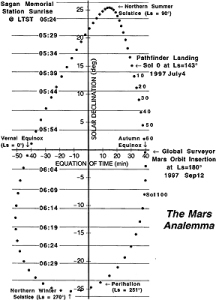
courtesy NASA
Many news outlets are running pictures taken by the Mars rover Opportunity today, on the tenth anniversary of its launch. Pictures taken by Opportunity have a date stamp that may seem surprising: for example, sol 3353. Time keeping on Mars is an interesting detail of the mission. A day on Mars is 2.4% longer than a day on Earth. Mission control crews work on Martian time. A day-shift assignment will turn into a night shift assignment, “sliding approximately 40 minutes later in Earth time each day. Wristwatches calibrated in Martian time, rather than Earth time, are used by many of the team members.” NASA scientists use the convention that the first day of operations of a Lander is called Sol 0, so I suppose pictures taken on the same day by different landers will have different Martian date stamps. There aren’t enough landers for that to get confusing… yet.

courtesy NASA
The motions of a planet make working by its own day and year the obvious choice. For craft in space, I suppose there is no reason to abandon Earth time, and specifically the Earth time of its mission control base. For anniversary celebrations, we might as well use Earth time. After all, we are the one’s who are celebrating.








July 5, 2013
Happy Anniversary, Opportunity
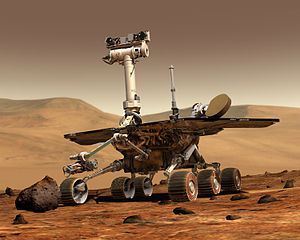 July 7 marks ten years since the Mars rover Opportunity lifted off from Earth. Like many snow birds, she is now headed for a sunnier slope to pass the Martian southern hemisphere winter. Getting there will take Opportunity past exposed layers of rock, “like walking up to a road cut where you see a cross section of the rock layers.” The traditional gift for a tenth anniversary may only be tin or aluminum, but Opportunity is giving golden data. http://1.usa.gov/1bdbWBi
July 7 marks ten years since the Mars rover Opportunity lifted off from Earth. Like many snow birds, she is now headed for a sunnier slope to pass the Martian southern hemisphere winter. Getting there will take Opportunity past exposed layers of rock, “like walking up to a road cut where you see a cross section of the rock layers.” The traditional gift for a tenth anniversary may only be tin or aluminum, but Opportunity is giving golden data. http://1.usa.gov/1bdbWBi








July 2, 2013
Eohippus angustidens – a Poem
 With thanks to Stephen Jay Gould:
With thanks to Stephen Jay Gould:
Eohippus angustidens
By Kate Rauner
Eohippus. Dawn Horse. What a perfect name
For the arch-backed little creature that was horses’ sire and dame.
But then a staid committee that sets official names,
By earlier citation found you to be
Hyracotherium
Hi – Ra – Ko – Ther – E- Um
I hated that decision; oh, I understand the rules.
Still Eohippus was so fine, the name a splendid jewel.
But Hyrax failed; it mixed its clades. Now beauty does prevail.
You’re Eohippus pretty tooth from nose to ropey tail.



















